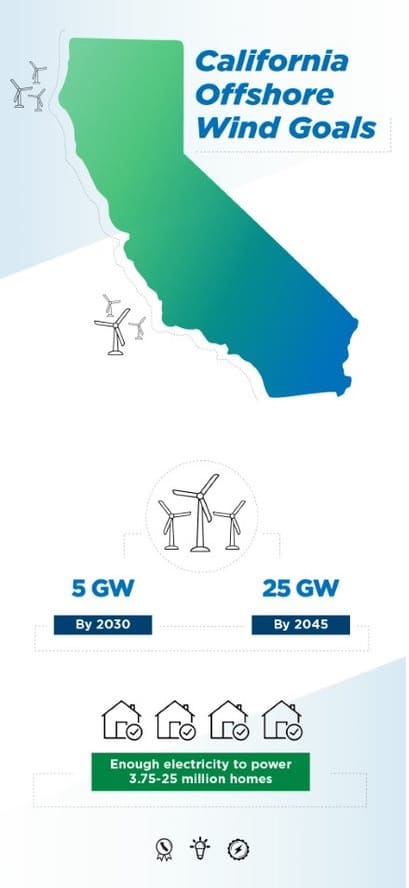California Adopts Offshore Wind Planning Goal of 25 Gigawatts, Largest of Any U.S. State

The California Energy Commission on Aug. 10 adopted a report establishing an offshore wind planning goal of 25 gigawatts by 2045. The report sets an interim planning goal range of 2 to 5 gigawatts by 2030, which could result in sufficient electricity to power 3.75 million initially and 25 million homes by mid-century.
The commission developed the report in collaboration with federal and state agencies and other stakeholders, including tribal governments, fisheries, and other ocean users. California’s Assembly Bill 525, signed into law in 2021, directed the commission to develop a strategic plan for offshore wind energy developments off the California coast in federal waters. The report outlines the technical potential for offshore wind tentatively at 21,800 megawatts and the commission would continue evaluating more prospects to establish the state’s maximum feasible capacity.
According to the report, California could achieve the high end of the 2030 goal by fully developing the Morro Bay wind energy area along the state’s central coast, or by partially developing the Morro Bay area and the two Humboldt areas, near the Oregon border, for which the U.S. Bureau of Ocean Energy Management intends to hold an auction. If fully developed, the bureau expects that wind farms in the two areas could produce up to 4.5 gigawatts.
The Biden administration aims to deploy 30 gigawatts of offshore wind in federal waters by 2030. The Interior Department proposed earlier this year to auction five areas off the coast of California near Morro Bay on the central coast and near Humboldt County on the north coast to meet that goal. Offshore wind projects have the potential to play a major role in meeting California’s climate policy goals, which include using renewables for 60 percent of the state’s electricity by 2030 on the way to a 100 percent zero-emissions grid by 2045, according to the commission.
In a statement, Business Network for Offshore Wind, an industry group, applauded the announcement and commended the commission’s work producing a strong implementation report. In the group’s view, the ambitious targets represent an important milestone in the development of a national floating offshore wind industry. According to the group, by establishing a 2045 goal, investors will be able to gain confidence and make investments in ports, vessels, and offshore wind manufacturing facilities throughout the pacific coast.
California’s goal is the largest of any U.S. state. New York has a goal of 9 gigawatts by 2035, North Carolina 8 gigawatts by 2040, and New Jersey 7.5 gigawatts by 2035.
EnerKnol Pulses like this one are powered by the EnerKnol Platform—the first comprehensive database for real-time energy policy tracking. Sign up for a free trial below for access to key regulatory data and deep industry insights across the energy spectrum.
ACCESS FREE TRIAL